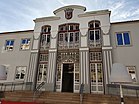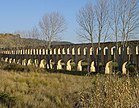Torres Vedras
This article includes a list of general references, but it lacks sufficient corresponding inline citations. (April 2021) |
Torres Vedras | |
|---|---|
|
Santa Maria do Castelo and São Gonçalo de Lagos | |
| Website | http://www.cm-tvedras.pt |
Torres Vedras (Portuguese pronunciation:
History

In 1148,
While travelling through this district, King Afonso III and Queen Beatrice, ordered the construction of a municipal hall, alongside the ancient castle (which today no longer exists). For his part, King Denis, his successor, was captivated by local Gracia Frois, fathering an illegitimate son, who would go on to be Count of Barcelos.
Later, the municipality was donated to the Queens of the realm, and in particular, under the Aviz dynasty, the Infanta
Torres Vedras continued to be a place of importance: in 1413, King
At the same time, intrigues and confrontations were fermented in Torres Vedras by local
In comparison, the loyalty and sympathies of the Portuguese of the region were tested with the French invasions of the Peninsular Wars (1808–1810). Anticipating the final defeat of the French, General Delaborde's forces were defeated on 21 August 1808, at the battles of Roliça and Vimeiro, by the Anglo-Portuguese Army that had landed at Porto Novo. Junot, who had installed himself in the town, signed a truce and left the town, retreating towards Lisbon, but not before sacking the churches and convents along the way.
Over 10,000 troops were involved in the bloody Battle of Torres Vedras, which resulted in the surrender of the Count's forces on 23 December 1846. The deaths of 400 men and 500 wounded, that included Lieutenant-Colonel
Following much of its history in battle, Torres Vedras lapsed into years of progress and development, supported by the expansion of the rail-lines in 1886, the installation of the electrical grid in 1912, and finally the canalization of waters to the town by 1926. These changes helped support a growth, construction of new barrios and roadways, resulting in the town's reclassification as a city in 1979.
Geography
|
Fronting the Atlantic Ocean, Torre Vedres is bordered by the municipalities of
The municipality covers an area of 407.15 square kilometres (157.20 sq mi).

The resident population of the city of Torres Vedras (approximately 20,000 inhabitants in two largest urban parishes) represents about 25% of the population of the municipality.
Climate
Torres Vedras has a
| Climate data for Dois Portos, Torres Vedras, 1961-1990 normals, 1931-1960 extremes & sunshine, 1984-2020 precipitation, altitude: 110 m (360 ft) | |||||||||||||
|---|---|---|---|---|---|---|---|---|---|---|---|---|---|
| Month | Jan | Feb | Mar | Apr | May | Jun | Jul | Aug | Sep | Oct | Nov | Dec | Year |
| Record high °C (°F) | 25.8 (78.4) |
23.0 (73.4) |
31.3 (88.3) |
32.0 (89.6) |
34.9 (94.8) |
37.3 (99.1) |
41.7 (107.1) |
44.5 (112.1) |
39.6 (103.3) |
35.5 (95.9) |
27.0 (80.6) |
26.2 (79.2) |
44.5 (112.1) |
| Mean daily maximum °C (°F) | 14.7 (58.5) |
15.8 (60.4) |
17.1 (62.8) |
18.9 (66.0) |
20.9 (69.6) |
24.0 (75.2) |
26.2 (79.2) |
26.6 (79.9) |
26.1 (79.0) |
22.9 (73.2) |
18.1 (64.6) |
15.2 (59.4) |
20.5 (69.0) |
| Daily mean °C (°F) | 10.0 (50.0) |
10.8 (51.4) |
12.2 (54.0) |
13.5 (56.3) |
15.6 (60.1) |
18.3 (64.9) |
20.4 (68.7) |
20.5 (68.9) |
19.9 (67.8) |
16.9 (62.4) |
12.9 (55.2) |
10.5 (50.9) |
15.1 (59.2) |
| Mean daily minimum °C (°F) | 5.3 (41.5) |
5.9 (42.6) |
7.3 (45.1) |
8.1 (46.6) |
10.2 (50.4) |
12.6 (54.7) |
14.7 (58.5) |
14.4 (57.9) |
13.7 (56.7) |
10.8 (51.4) |
7.7 (45.9) |
5.7 (42.3) |
9.7 (49.5) |
| Record low °C (°F) | −5.7 (21.7) |
−6.0 (21.2) |
−2.0 (28.4) |
−0.8 (30.6) |
2.7 (36.9) |
5.4 (41.7) |
4.2 (39.6) |
5.2 (41.4) |
3.4 (38.1) |
0.0 (32.0) |
−4.5 (23.9) |
−5.5 (22.1) |
−6.0 (21.2) |
| Average precipitation mm (inches) | 99.8 (3.93) |
81.2 (3.20) |
47.6 (1.87) |
77.0 (3.03) |
58.9 (2.32) |
20.9 (0.82) |
8.2 (0.32) |
7.5 (0.30) |
32.4 (1.28) |
101.0 (3.98) |
120.6 (4.75) |
103.2 (4.06) |
758.3 (29.86) |
| Average relative humidity (%)
|
84 | 82 | 76 | 77 | 75 | 75 | 73 | 74 | 75 | 78 | 81 | 83 | 78 |
| Mean monthly sunshine hours | 137.2 | 154.2 | 176.0 | 223.2 | 246.0 | 264.2 | 308.9 | 295.7 | 234.5 | 191.4 | 140.0 | 115.1 | 2,486.4 |
| Source 1: Instituto de Meteorologia[4][5][6] | |||||||||||||
| Source 2: Portuguese Environment Agency (precipitation)[7] | |||||||||||||
Economy and tourism
In 2011, Torres Vedras received the QualityCoast Gold Award for its efforts to become a sustainable tourist destination, and was selected for inclusion in the global atlas for
The
Sport
The local professional football team is S.C.U. Torreense which plays at the Manuel Marques Stadium.
Notable People

- Empress of the Holy Roman Empire
- Lopo Soares de Albergaria (c.1460 – c.1520) the third Governor of Portuguese India
- Cristóvão Ferreira (c.1580–1650) a priest and Jesuit missionary who committed apostasy in Japan
- Luís da Silva Mouzinho de Albuquerque (1792–1846) a military officer, poet, scientist and politician
- Manuel Clemente (born 1948) a prelate of the Catholic Church; the Patriarch of Lisbon since 2013
- Carlos Miguel (born 1957) a lawyer, politician and Govt. minister of Romani ethnicity
- Guta Moura Guedes (born 1965) curator, author, journalist and television presenter.
- Beto (1967–2010) a Portuguese singer; lived in Torres Vedras from aged 17
- Susana Félix (born 1975) a singer, songwriter, musician, actress and producer.[10]
- Cristina Ferreira (born 1977), journalist, businesswoman and TV host.[11]
- Bernardo Blanco (born 1995), politician and Member of Parliament.
- Lisandro Cuxi (born 1999 in Zambujal) a Portuguese–Cape-Verdean singer-songwriter and dancer.
Sport

- José Pereira (born 1931) a football goalkeeper with 302 caps with Belenenses and 11 for Portugal
- Joaquim Agostinho (1942 – 1984) professional bicycle racer
- Académica
- Hélder Baptista (born 1972) a retired footballer with 311 club caps
- Nelson Pereira (born 1975) football goalkeeper with 201 club caps and 3 for Portugal
- Zé António (born 1977) a Portuguese former footballer with 451 club caps
- Anselmo Cardoso (born 1984 in Freiria) a former footballer with 267 club caps
- André Santos (born 1989) football player with 300 club caps
- Henrique Chaves (born 1997) a Portuguese racing driver.
- Fábio Carvalho (born 2002) footballer who plays for Liverpool.
See also
- Torres Vedras IPR
- Leonel Trindade Municipal Museum, Torres Vedras
- List of forts of the Lines of Torres Vedras
References
Notes
- ^ a b "Statistics Portugal - Web Portal".
- ^ a b "Áreas das freguesias, concelhos, distritos e país". Archived from the original on 2018-11-05. Retrieved 2018-11-05.
- ^ Diário da República. "Law nr. 11-A/2013, page 552 122" (PDF) (in Portuguese). Retrieved 3 August 2014.
- ^ "Plano Municipal de Defesa da Floresta Contra Incêndios" (PDF). Torres Vedras Municipality. Retrieved 10 June 2021.
- ^ O Clima de Portugal: Normais climatológicas do Continente, Açores e Madeira correspondentes a 1931-1960. Serviço Meteorológico Nacional, Observatório do Infante D. Luís (Lisboa). 1965. p. 94. Retrieved 14 July 2021.
- ^ O Clima de Portugal: Normais climatológicas do Continente, Açores e Madeira correspondentes a 1931-1960. Serviço Meteorológico Nacional, Observatório do Infante D. Luís (Lisboa). 1965. p. 95. Retrieved 14 July 2021.
- ^ "Orjariça (19B/05C), 1984-2021". snirh.apambiente.pt. Retrieved 10 June 2021.
- ISSN 1877-7953, archived from the original(PDF) on 2019-04-01
- ^ "Museu Municipal Leonel Trindade". Patrimonio Cultural. Retrieved 4 March 2019.
- ^ Susana Félix, IMDb Database retrieved 05 July 2021.
- ^ Cristina Ferreira, IMDb Database retrieved 04 July 2021.
Sources
- Sales, António Augusto (December 2007), Roteiro Turístico de Torres Vedras (in Portuguese), Torres Vedras, Portugal: Câmara Municipal de Torres Vedras







